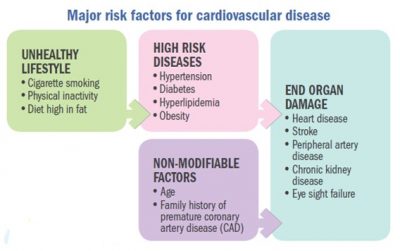Early detection prevents complication such as heart failure, stroke, kidney disease and artery disease. Heart disease is 1 of the top leading cause of death worldwide and affects not only the heart but other major parts of the body. Early detection prevents complication such as heart failure, stroke, kidney disease and artery disease.
Heart (Cardiovascular) Screening
Heart disease is a broad term that uses to describe a range of diseases of the heart and blood vessels. Heart disease is often used interchangeably with cardiovascular disease.
Why is cardiovascular screening important?
Cardiovascular disease begins with damage to the body from lifestyle factors like smoking, physical inactivity and an unhealthy diet. This progresses to the development of high-risk diseases such as obesity, high blood pressure and diabetes.
Screening identifies those at risk of future cardiovascular events of the heart and other major body organs. It also identifies those with modifiable risk factors, which are reversible and reduce one’ s risk of developing cardiovascular disease.

Who should go for the screening of cardiovascular risk factors?
- Every adults aged 18 years and above should go for the screening of cardiovascular risk factor
- Patients with diabetes, high blood pressure
- Long-standing kidney disease patients
the above are those who are having a higher risk for cardiovascular disease and should be screened regularly based on their doctor’s advice.
Cardiovascular Risk Assessment
What is the global cardiovascular risk assessment?
Global cardiovascular risk assessment involves assessing a patient’s total cardiovascular risk rather than just assessing risk factors (high cholesterol, blood pressure, diabetes or obesity) in isolation.
The best known global cardiovascular risk assessment tool is the Framingham Risk Score (FRS). Based on the FRS adapted for local use, the risk for an asymptomatic individual is classified as:
- Low-risk corresponding to <10% risk of vascular events* over a ten-year period
- Intermediate-risk corresponding to 10-20% risk of vascular events over a ten-year period
- High-risk corresponding to >20% risk of vascular events over a ten-year period
*These vascular events include heart attack and coronary death.
It should be done every five years starting from the age of 18 years. For individuals at risk but who have no symptoms, the assessment is followed by advice on making certain lifestyle changes such as cutting back on cigarettes, eating healthy foods and exercising regularly and, where appropriate, medicines are given to treat high blood pressure, high lipids and diabetes. Individuals at low risk should continue to lead a healthy lifestyle. More frequent assessment is recommended for those who are diabetic, chronic smokers or obese.
How to calculate the ten-year coronary artery disease risk?
It is calculated based on:
Age
Sex
Ethnicity
Smoking status
Total and High-Density Lipoprotein (HDL) or good cholesterol level
Systolic blood pressure

Additional Screening Tests
What additional screening tests may be needed following global cardiovascular risk screening?
These additional tests may be needed for cardiovascular evaluation of individuals moderate and high risk without any symptoms.
- Resting Electrocardiogram (ECG)
- Exercise Treadmill Test
- Coronary artery calcium score
- Cardiac stress imaging (Stress Echocardiology)
- CT Coronary angiography
- Carotid intima-media thickness
When should screening for body mass index (BMI), waist circumference, high blood and high cholesterol be done?
Pre-exercise Screening
It helps identify those at risk for the cardiovascular event during exercise. The questionnaire below recommended for safety reasons before participating in any physical activity.
Physical Activity Questionnaire (PAR Q) can be obtained from HPB (https://www.healthhub.sg/sites/assets/Assets/Programs/NSC-Corporate/Season-4/pdfs/PAR-Q.pdf)
Follow-up on the Results of Screening for Cardiovascular Disease and Risk Factors
Discuss the result of your screening with your doctor and know what you can do to live a healthy lifestyle as well as ways to prevent and treat your medical conditions.
Table of reference – Live a healthy lifestyle
| What you can do | Recommendations |
|---|---|
| Healthy eating | Eat five to seven servings of rice and alternatives daily (of which two to three servings should be wholegrain products)
Eat two servings of fruits and two servings of vegetables daily Eat two to three servings of meat and alternatives daily (of which half a serving should come from dairy or other high calcium products) Use fats, oils and salt sparingly to flavour food Drink six to eight glasses of fluid (1.5 to 2.0 litres) daily |
| Maintain a healthy weight | Target to have your BMI between 18.3 to 22.9 kg/m2
Keep your waist circumference equal or less than 80 cm for women 90 cm for men If you are overweight, aim to lose only 0.5 kg per week. A slow and steady weight management is healthier and easier on the body |
| Engage in regular physical activity | If you are not exercising regularly, start today with ten minutes of brisk walking and build up as your physical fitness improves. You will enjoy the better health that comes with regular exercise
Target to exercise regularly e.g. brisk walking 30 minutes a day five days a week, or a pedometer reading of 10,000 steps a day If you enjoy doing other exercises, be regular in doing them |
| Cut back on cigarettes | See your doctor if you need help to quit smoking or to discuss more about it |
| Limit alcohol use | Avoid alcohol bingeing
Ask your doctor s advice on setting the limits on alcohol consumption |
Table of Reference – Prevent your medical conditions
| What you can do | Recommendations |
|---|---|
| Keep your cholesterol levels in check | Desirable levels are:
Total Cholesterol Less than 5.2 mmol/L (200 mg/dL) Check with your doctor the levels to set for yourself |
| Keep your blood pressure levels in check | Normal blood pressure levels are:
Systolic BP Less than 130 mm Hg |
| Keep your blood sugar levels in check | Optimal (target goal for majority of patients) are:
HbA1c 6.5 7.0% Check with your doctor the levels to set for yourself |
| Take your medications regularly | Take your medicines regularly even if you feel well
Check with your doctor on the targets of control if they are not optimal |
| Go for regular monitoring if you have chronic medical conditions | You need regular monitoring if you have high cholesterol levels, high blood pressure or diabetes |
